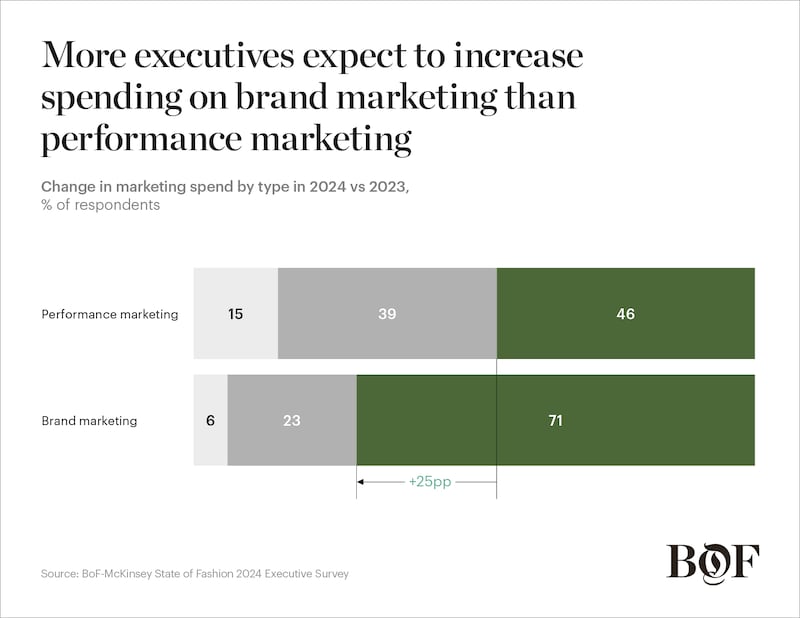
The Business of Fashion
Agenda-setting intelligence, analysis and advice for the global fashion community.

Agenda-setting intelligence, analysis and advice for the global fashion community.

 Opens in new window
Opens in new windowBrand-building isn’t what it used to be. After years of leaning heavily on instantly trackable performance marketing, the fashion marketing landscape is shifting. A convergence of factors, including pressures on discretionary spend, is sharpening consumer appetite for entertaining brand storytelling that captures their aspirations and interests, well beyond the products on offer. Spurring this change are the increasing costs of performance marketing alongside new data privacy regulations restricting customer targeting, forcing marketers to find different ways to engage with shoppers.
Many fashion leaders now plan to reprioritise marketing spend. According to the BoF-McKinsey State of Fashion 2024 Executive Survey, 71 percent of executives plan to increase brand marketing spend in 2024, while 46 percent intend to do the same for performance marketing. This marks a fundamental shift for many fashion companies, including direct-to-consumer labels that have built their brands using the trackable, targeted performance-marketing playbook.
While brand marketing by its very nature doesn’t enable the same depth of trackable insights as performance marketing, it does offer other benefits — notably, done effectively, it can help brands to stand out in an increasingly saturated media world. Brand marketing is also proving to be pivotal in transforming a label’s market position, while often helping it capture entirely new customer bases.
Effective brand marketing needs to employ a multi-pronged strategy over time, rather than one-off moments. Sustained, holistic brand marketing can transform brand images, as several recent examples show.
ADVERTISEMENT
Germany-based Hugo Boss launched an image reboot with heavy investment in brand marketing that aimed to attract young consumers. With newly differentiated branding for “Hugo,” aimed at Gen-Z, and “Boss,” aimed at Millennials, it updated its logo and other visual cues and enlisted ambassadors like Hailey Bieber, rolling out a star-studded web and out-of-home campaign and hosting events including see-now-buy-now fashion shows and sponsoring sporting events to feature its new streetwear-influenced looks. In March 2023, the company announced the first full-year results since the rebrand, attributing record sales of €3.65 billion ($3.85 billion) in large part to the “momentum” throughout 2022 it gained from the new-look Boss and Hugo brands.
Italian luxury house Ermenegildo Zegna Group began a refresh of its Zegna menswear brand in the run-up to its initial public offering in 2021. The brand streamlined and modernised its image, dropping “Ermenegildo” from its name and condensing three sub-brands into one modern, slick Zegna-branded umbrella. The company also collaborated with luxury streetwear label Fear of God to tap into a broader, younger audience as part of a wider casualisation campaign, which expanded Zegna’s brand authority from tailored suits to luxury leisurewear for the modern quiet luxury consumer. Zegna’s full-year 2022 sales rose 16 percent year on year to €1.5 billion ($1.6 billion).
Meanwhile, New Balance has used collaborations as a part of its broader strategy to elevate the brand and drive demand. In addition to targeted inventory allocation across channels, product drops and marketing investments, the sneaker brand leveraged tie-ups with image-driving partners, such as JJJJound, Miu Miu, Joe Freshgoods and Aimé Leon Dore, while tapping ALD’s Teddy Santis to be creative director of New Balance Made in USA. These actions have reinforced New Balance’s brand positioning, with it ranking as one of the best-selling brands on sneaker resale platforms Goat, StockX and Flight Club.

As consumers crave greater connection and authenticity from brands, marketing efforts will home in on brand storytelling and emotional affinity through multiple avenues.
One way this can be done is by leveraging the personalities behind a brand, such as the founder or creative director. Think Miu Miu (Miuccia Prada) or Loewe and JW Anderson (Jonathan Anderson) or Jacquemus (Simon Porte Jacquemus) — labels that featured in the recent quarterly Lyst index of fashion’s most prominent brands. Underscoring how many consumers gravitate towards the people who personify and drive a brand, organic content can be created around these personalities in authentic, personable ways.
However, there are other ways to build communities that don’t rely on a brand’s stand-out personality. In the case of Nike, bold ad campaigns featuring high-profile athletes have over the years created a perception around the brand for focusing on social causes. Meanwhile, as heritage luxury brands have shown, there’s plenty of scope for storytelling that pivots around other aspects of their brands’ unique qualities. Hermès, for example, has long employed deep brand stories that evoke a history of craftsmanship. At Tiffany & Company, the brand was revitalised after its acquisition by LVMH, balancing established brand stories and new campaigns with stars like musicians Jay-Z and Beyoncé to access a new generation of consumers.
There’s also a brand marketing opportunity by creating memorable shopping moments. Connecting emotionally with consumers has become increasingly difficult in a world of ever-shortening attention spans. However, by meeting consumers in the real world with activations that span channels, brands can capture attention and build a more pervasive presence in customers’ lives. Immersive stores, featuring visually striking spaces and interactive, multisensory experiences, can be employed here. A range of brands have already been experimenting with boldly designed pop-ups which often have the additional benefit of serving as ideal backdrops for shoppers’ social media posts. Examples include Jacquemus’s handbag vending machines, Chanel’s perfume-themed diner, H&M’s immersive collection launches and Pretty Little Thing’s themed influencer showroom.
Melding marketing strategies with adjacent industries such as music, film and sports, is also helping fashion brands remain relevant with customers. In 2024, brands may consider investing further in cross-industry collaborations, joint ventures and sponsorships. LVMH announced its “premium” sponsorship deal of the 2024 summer Olympic and Paralympic Games in Paris, with plans for individual brands to make standout contributions in the run-up to the games. Following on the heels of LVMH’s news, Kering-owner François-Henri Pinault announced that his family’s holding company Artémis had closed a multi-billion-dollar deal to acquire a majority stake in Hollywood talent giant Creative Artists Agency, perhaps a precursor to fashion players inking more cross-cultural deals.
ADVERTISEMENT
Succeeding as a brand in 2024 may require a shift in priorities — selectively using brand-building tools to develop compelling brand stories, supported by a long-term strategy and underpinned by the right talent and channel investments.
Chief marketing officers and their teams will need a laser-sharp focus on customer perception and cross-funnel strategy, working with creatives and brand specialists as well as data, finance and strategy leaders to form a cohesive brand story. After years of focusing on performance marketing, CMOs must now invest in hiring and training teams to bolster brand marketing capabilities, ensuring that the marketing department contains both brand and performance marketing specialists that can work closely together. Indeed, more companies may hire chief brand officers as brands take a more holistic view of their storytelling and marketing efforts.
Undergirding this is a focus on the long-term story. This will require a mentality shift, with impact measurement focused on longer-term, strategic horizons, rather than instant return on investment — while blockbuster marketing campaigns can generate immediate buzz, maintaining consumer attention thereafter is a challenge. Consumers expect to see brand stories that are consistent and authentic; the success of purpose-led brands such as Patagonia are proof points. Brand marketing may need to be maintained with consistent storytelling throughout consumers’ day-to-day lives, from large-scale events to touchpoints on social media. However, 2024 won’t be about generating more and more content, or perpetually refreshing brand identities. Now, the focus needs to be on “less is more,” with carefully crafted storytelling that amplifies a brand’s clear, coherent personality.
This article first appeared in The State of Fashion 2024, an in-depth report on the global fashion industry, co-published by BoF and McKinsey & Company.
The eighth annual State of Fashion report by The Business of Fashion and McKinsey & Company reveals an industry navigating deep uncertainty. Download the full report to understand the 10 themes that will define the industry and the opportunities for growth in the year ahead.
Calvin Klein’s chief marketing officer Jonathan Bottomley speaks to Imran Amed about the strategy behind the brand’s buzzy Jeremy Allen White-fronted campaign.
Often left out of the picture in a youth-obsessed industry, selling to Gen-X and Baby Boomer shoppers is more important than ever as their economic power grows.
This month, BoF Careers provides essential sector insights to help PR & communications professionals decode fashion’s creative landscape.
The brand’s scaled-back Revolve Festival points to a new direction in its signature influencer marketing approach.